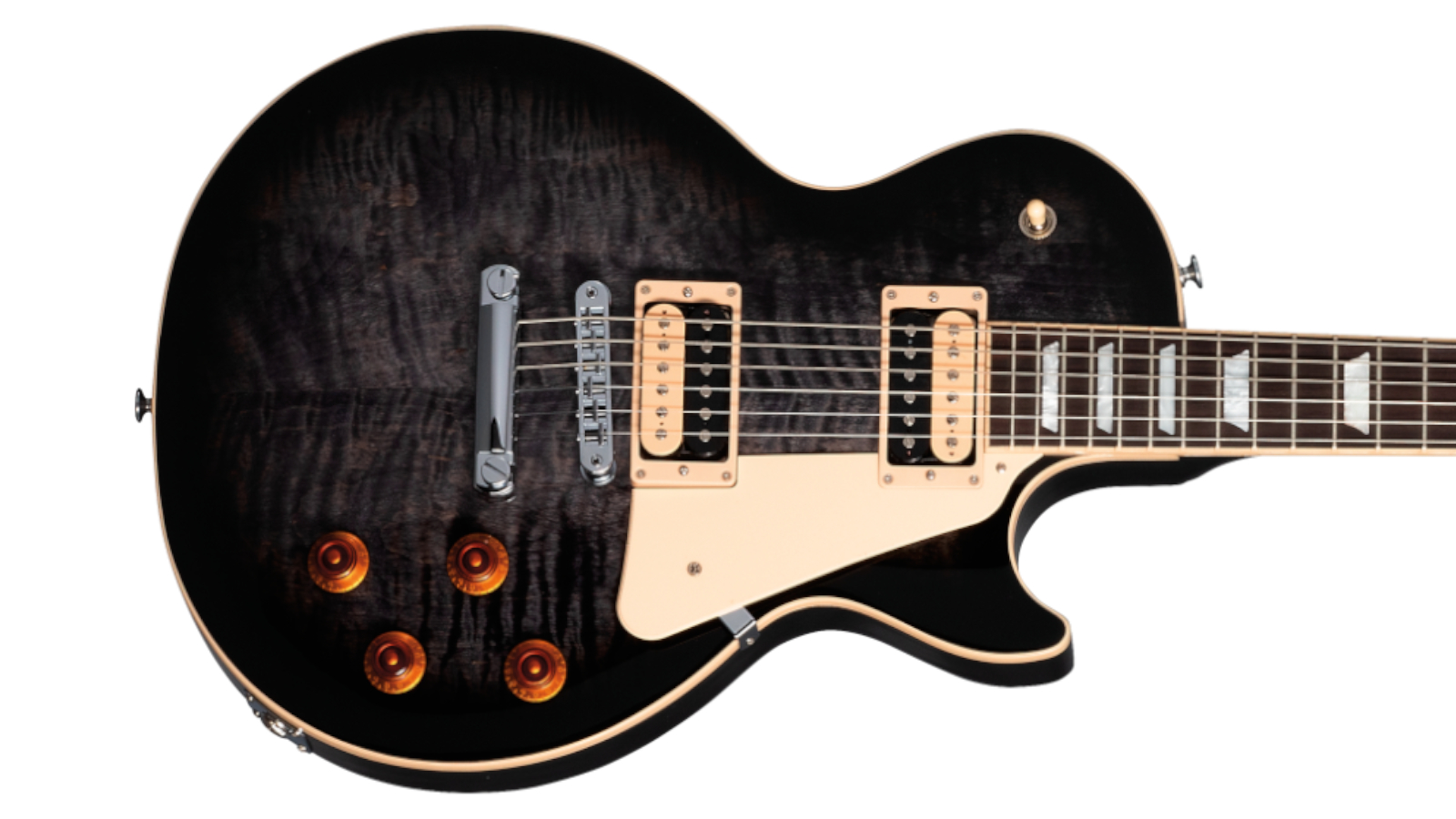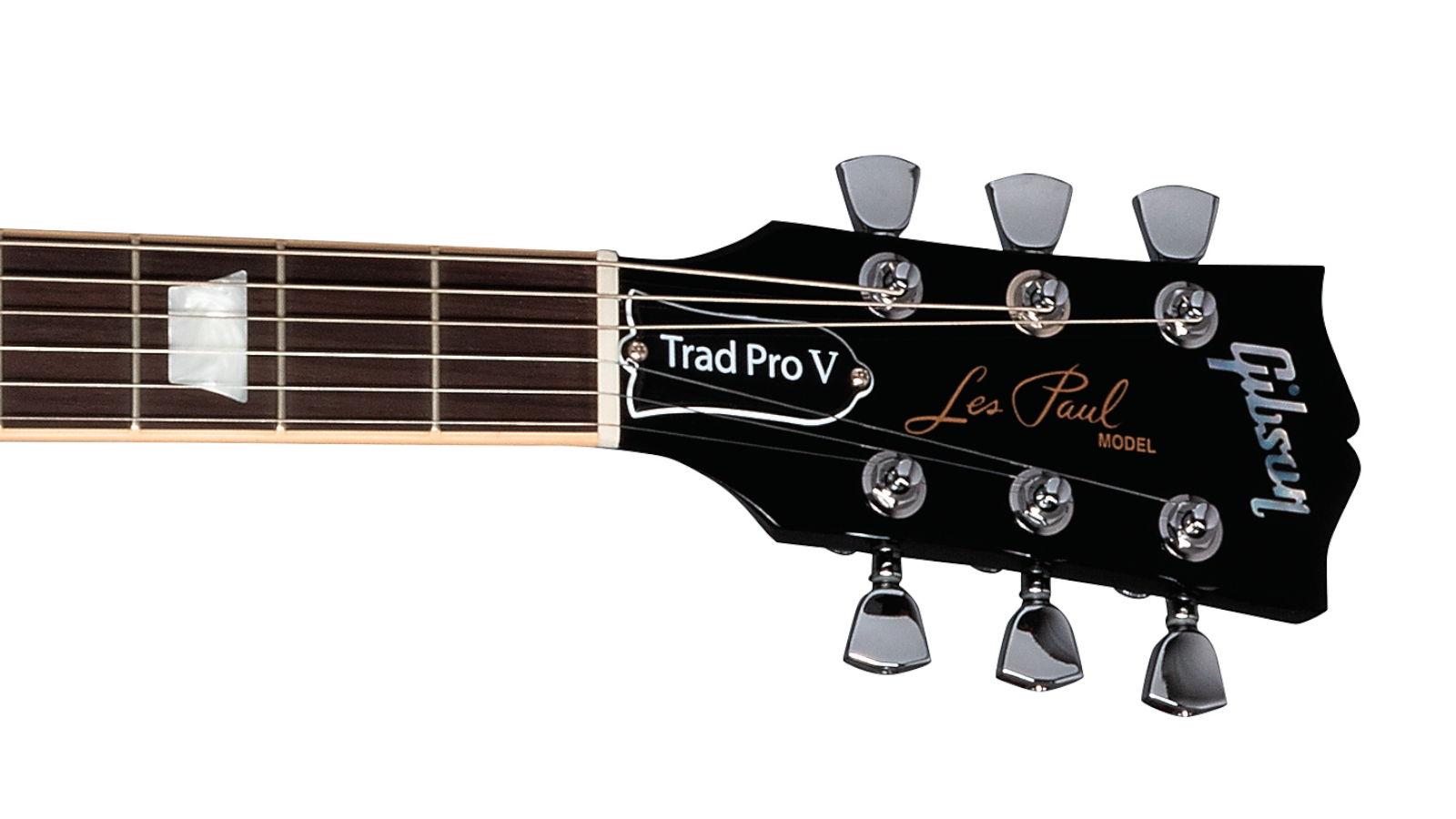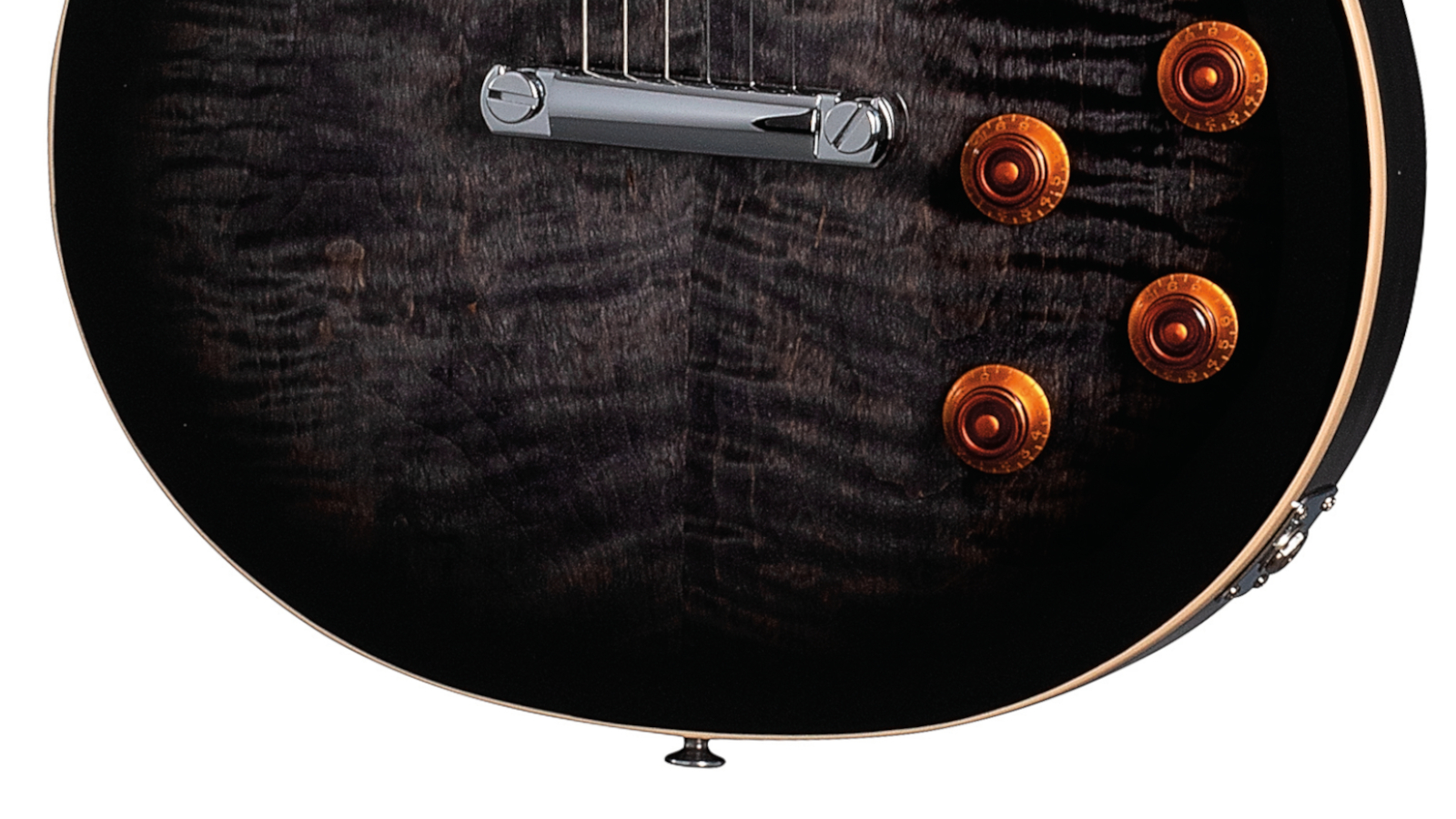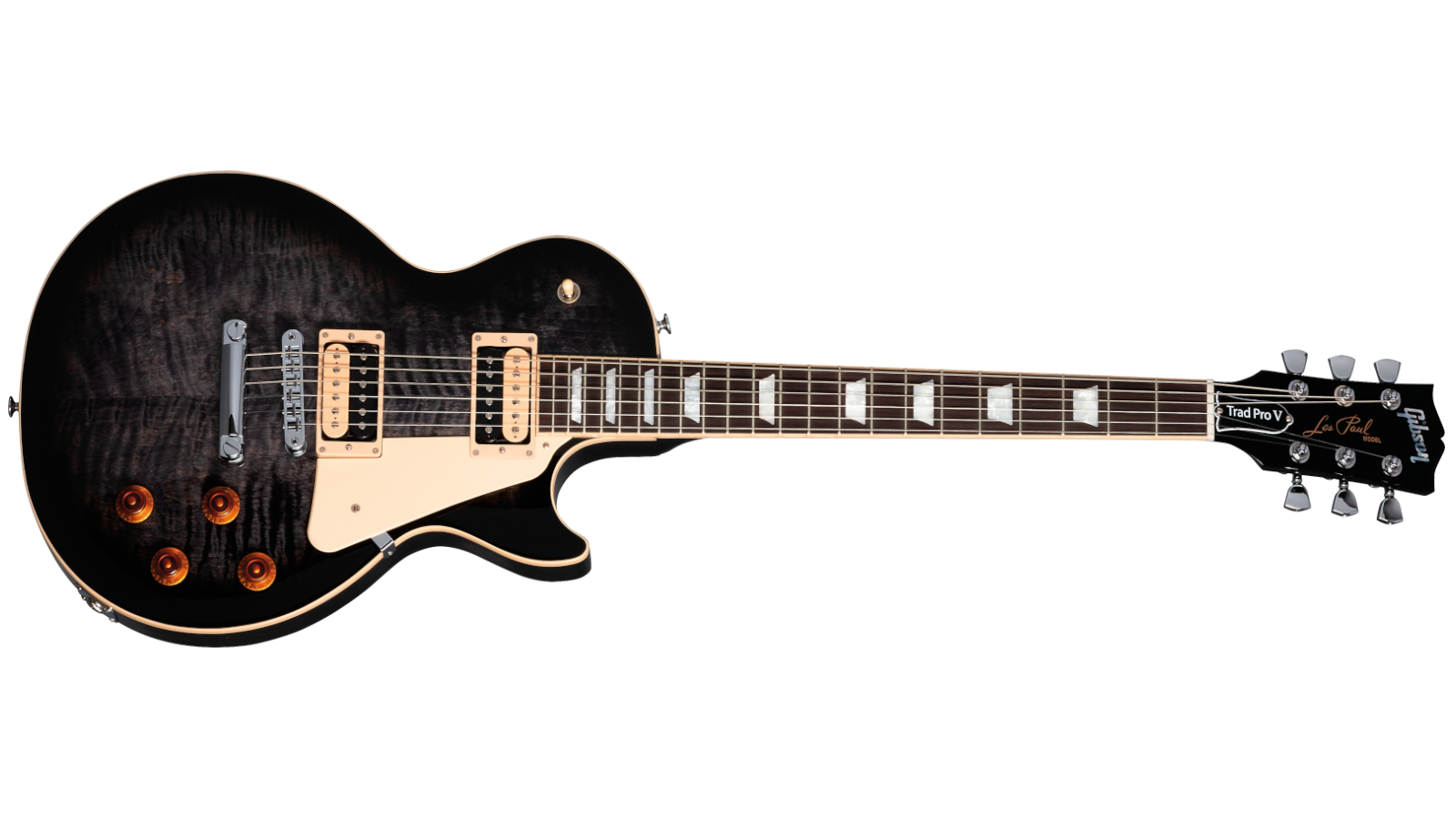GuitarPlayer Verdict
A very flexible tone crafter that’s sure to excite a lot of eager players
Pros
- +
A well-built Les Paul in the grand tradition, boasting a plethora of tone-crafting options courtesy of clever switching systems
Cons
- -
It leans a little heavy for a weight-relieved instrument
You can trust Guitar Player.
American guitar makers’ collaborations with major retailers have occasionally resulted in some gems with staying power beyond their original “exclusive-to” intentions. The Gibson USA Les Paul Traditional Pro V is just such a guitar.
It retains the raft of hot-rod features that make it a superbly versatile performer
Offered exclusively for several years by Gibson and Guitar Center, it has been updated for 2023 with two sumptuous new finishes: Transparent Ebony Burst over a flame-maple top (as reviewed here), and a satin Desert Burst on a plain maple top. Otherwise, it retains the raft of hot-rod features that make it a superbly versatile performer.
Outwardly, it appears to be a dead-standard Les Paul, and given guitarists’ famously traditional leanings, that’s clearly the idea. But scratch the surface and just about every component hides a notable modification that takes this modern ’Burst’s capabilities way beyond the ordinary.
Construction follows the traditional Les Paul template, featuring a solid mahogany body capped with a carved flame-maple top, a glued-in mahogany neck, and a bound 22-fret rosewood fingerboard, all to a 24.75-inch scale length.
But even these basic specs hide several unseen alterations.


The fingerboard sports a compound radius that flattens out gradually as you progress toward the body, and the neck back is carved to an asymmetrical update of the traditional SlimTaper neck profile, resulting in slightly more depth front-to-back at the bass side of the carve and helping it fit the curve of the hand a little better.
Close examination reveals that Gibson USA’s construction is generally excellent
Finally, the body has been weight relieved with nine large, round holes drilled into the mahogany before the top is glued on. Even so, it leans a tad on the heavy side at a shade under 10 pounds, although we’d have considered this a light one back in the ’70s or ’80s, so I guess it’s all a matter of perspective.
All the latest guitar news, interviews, lessons, reviews, deals and more, direct to your inbox!
Close examination reveals that Gibson USA’s construction is generally excellent. There’s just a tiny bit of ledge where the top binding meets the body and some barely perceptible orange peel at the back of the neck heel, where the nitro has rippled in the wood grain, but the finish is well shot otherwise and particularly stunning where the Transparent Ebony Burst reveals some beautifully figured maple in the guitar’s top.
For another entry in the tasty timber department, the rosewood fretboard on this example is an appealing dark-chocolate brown, with some lovely subtle striping in the grain.

As for general ergonomics, the guitar plays smoothly right out of the case, benefiting from a confident setup that delivers easy action and accurate intonation right up the neck. It boasts a lively, resonant ring when played unplugged, too.
The guitar plays smoothly right out of the case, benefiting from a confident setup that delivers easy action and accurate intonation right up the neck
Down at the body end, the hardware includes an aluminum stopbar tailpiece behind a Nashville Tune-o-matic bridge. The headstock carries locking Grover tulip-button tuners and a “Trad Pro V” engraved truss-rod cover beneath the inlaid pearl Gibson logo and stenciled “Les Paul Model” signature.
I also like the slightly larger strap buttons, compared to the tiny vintage-spec buttons, whose use always puzzled me, given that this is one of the guitars more likely to suffer a headstock break when dropped.
Alongside the modifications to vintage spec, the pickups and electronics are the Les Paul Traditional Pro V’s biggest bragging rights. The open zebra-coil humbuckers in this model are Gibson’s Tradbuckers, made to the traditional PAF formula, with offset coils that are also a little underwound in the neck position and slightly overwound in the bridge (resistance-wise, that translates to 7.49k ohms and 8.44k ohms, respectively).

Each carries an Alnico V bar magnet and has four-conductor wiring to enable a plethora of switching options. And switching options there are! Push-pull switches on every volume and tone potentiometer are further enhanced by a block of five DIP switches housed within the control cavity.
Push-pull switches on every volume and tone potentiometer are further enhanced by a block of five DIP switches housed within the control cavity
Comprising Gibson’s HP-4 High Performance Circuit, they offer – depending on DIP positions – tap or split of each pickup, out-of-phase (with the neck tone up), and outer coils or inner coils for the split (with the bridge tone up or down), respectively. DIP switches three and four determine whether each pickup’s volume control has its high-pass filter engaged (to retain treble when rolled down), while the fifth DIP switch enables a Transient Suppression circuit when on.
Developed by GP contributor Craig Anderton, this circuit (which is in the public domain) reduces the signal peaks somewhat like a compressor or limiter and is particularly useful when recording direct into digital interfaces to help avoid nasty clipping in the AD conversion.
Tested through a 1966 Fender Princeton combo and a 65amps London tube amp head and 2x12 cab, the Les Paul Traditional Pro V revealed a chameleon-like sonic personality couched in a bevy of classic Les Paul tones that easily justify the Traditional part of its name.

First and foremost, this is a solid, muscular Les Paul in the grand style: Chunky rhythm, singing lead tones and a beefy yet articulate voice are all front and center, so the Traditional Pro V can easily be aimed at anything you’d have used a more “standard” Standard for in the past. As such, it was a lot of fun just getting lost in the riffing, the way these electric guitars have always inspired me to do, particularly with a Friedman Smallbox MIAB overdrive pedal into the London rig for some Plexi-like graunch.
Start messing with the switching options and the sky’s the limit for tone-crafting
Start messing with the switching options and the sky’s the limit for tone-crafting. I was pretty good at math back in the day and still don’t have time to run the numbers on the sonic options available here, nor space to describe them all. Having played through most major combinations, though, it was easy to hear what a boon this could be to your recording efforts in particular, while a couple of alternatives could certainly benefit live use.
For me, however, the plethora of variables also presented a potential downside when I wanted to just keep playing and not have to wonder, But what if I popped out this knob and flicked this DIP switch? But that’s a “me” problem, as they say.
All in all, Gibson’s latest Les Paul Traditional Pro V is a solid performer in the dual-humbucker, single-cutaway set-neck tradition and a very flexible tone crafter. And undoubtedly, that’s sure to excite a lot of eager players.

SPECIFICATIONS
- NUT: GraphTech NuBone, 1 11/16” wide
- NECK: Mahogany, asymmetrical SlimTaper profile
- FRETBOARD: Rosewood, 24.75” scale, compound radius
- FRETS: 22 modern
- TUNERS: Grover locking
- BODY: Weight-relieved mahogany with carved flame-maple top
- BRIDGE: Nashville Tune-o-matic with aluminum stopbar tailpiece
- PICKUPS: Two Gibson Tradbuckers
- CONTROLS: Volume and tone for each pickup, push-pull switching on each plus five DIP switches for split/tapped, out of phase, individual high-pass filter on/off, and transient suppression
- FACTORY STRINGS: Gibson .010–.046
- WEIGHT: 9.8 lbs
- BUILT: USA
Visit Guitar Center for more information.
Dave Hunter is a writer and consulting editor for Guitar Player magazine. His prolific output as author includes Fender 75 Years, The Guitar Amp Handbook, The British Amp Invasion, Ultimate Star Guitars, Guitar Effects Pedals, The Guitar Pickup Handbook, The Fender Telecaster and several other titles. Hunter is a former editor of The Guitar Magazine (UK), and a contributor to Vintage Guitar, Premier Guitar, The Connoisseur and other publications. A contributing essayist to the United States Library of Congress National Recording Preservation Board’s Permanent Archive, he lives in Kittery, ME, with his wife and their two children and fronts the bands A Different Engine and The Stereo Field.


